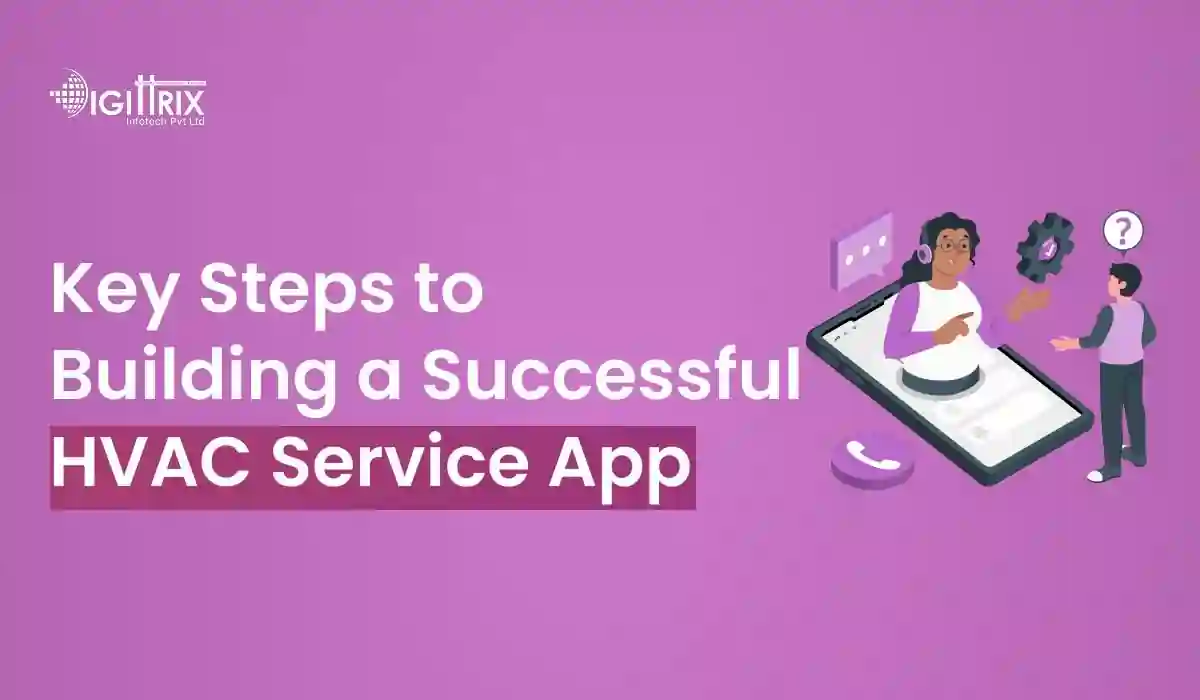Build a powerful HVAC service mobile app to manage bookings, technicians and payments, simplifying your business operations and improving customer satisfaction in a digital world
Highlights
With Over 14 years of Experience in the IT Field, Helping Companies Optimise there Products for more Conversions

The Heating, Ventilation and Air Conditioning (HVAC) industry is a crucial part of modern living, providing comfort and air quality for homes, businesses, and industries. As technology becomes a major part of everyday business, many HVAC companies are turning to software and mobile apps to enhance their service delivery. If you are considering how to build your HVAC service app, this guide will help you understand everything involved, from planning to development, features and benefits.
An HVAC service mobile app is a specialized software application designed to assist HVAC businesses and their customers. It helps schedule appointments, manage technician dispatch, estimate job costs, track inventory, and process invoicing and payments, all from a smartphone or tablet. This app connects customers with heating, cooling, refrigeration, and ventilation professionals, allowing for easy booking and fast service.
Small HVAC businesses and large companies alike find that a custom HVAC service app provides a better way to manage everyday tasks, including billing, quoting, service proposals, and even customer relationship management (CRM). WorkWave reports indicate that 52% of service businesses now offer apps for scheduling and customer interaction.
Planning to build business software? Explore the 10 must-have features to ensure efficiency and success.
With more people relying on their phones to book services, having an app puts your HVAC business at their fingertips. Customers appreciate quick access to services such as ductwork inspection, system troubleshooting, preventive maintenance, and emergency repairs. Using on-demand app development strategies tailored for HVAC allows your business to manage:
Building an HVAC service app helps keep all these functions organized and accessible, leading to increased efficiency and customer satisfaction.
When you choose to build an HVAC service app, including the right features is essential. These features support field technicians, office staff and customers.
Allow users to register and log in easily using email, phone, or social media. Technicians and contractors get their accounts to view schedules, job details and customer information.
Display detailed HVAC services such as heating system installation, refrigeration repair, ductwork design and fabrication and air quality control. Include features for estimating and quoting prices based on job complexity and materials used.
Provide tools for customers to book HVAC appointments, including maintenance, diagnostics and emergency repairs. Dispatch teams efficiently with real-time updates and technician tracking on maps.
Include billing and invoicing modules that integrate with accounting and bookkeeping programs. This allows contractors and businesses to generate proposals, send invoices and track payments with ease.
Track tools, equipment, parts and HVAC assets like air handlers, compressors, ductwork and refrigeration units. Manage inventory levels, reordering and asset allocation for technicians.
Manage contracts for preventative maintenance, commissioning and installation projects. Organize work orders, checklist inspections and service reports digitally.
Keep detailed records of customers, their service history and preferences. This supports targeted sales efforts and follow-up reminders for maintenance or upgrades.
Send reminders for upcoming appointments, job status updates, payment due dates and promotional offers.
Housecall Pro states that mobile apps increase booking rates by up to 30% for HVAC and home service businesses.
Before starting, research the HVAC industry’s needs and competitors. Look at existing software such as Servicetitan, SERA and Elite to understand key features like load calculation, energy modeling, or duct sizing.
Hiring an experienced app development company is critical. They should understand HVAC systems, software needs, etc. Such companies provide development, testing, deployment and post-launch support.
Decide on the key modules, such as scheduling, dispatch, invoicing, or CRM and design simple, user-friendly interfaces for both customers and technicians.
App developers will use tools like Flutter, React Native, or Swift/Kotlin for mobile app development. Backend programming involves database management (e.g., MySQL, PostgreSQL) to store customer data, job history and inventory.
Test the app on various devices and platforms for performance, usability and security. This includes testing HVAC-specific features like thermal load calculations, 3D duct layout and refrigeration diagnostics.
Once complete, the HVAC service app is published on app stores. Promote it through websites, social media and direct outreach to HVAC businesses.
Building a quality HVAC app requires combining multiple technologies:
When building your HVAC service app, security must be a priority. Implement strong encryption for sensitive data, secure user authentication and compliance with data protection laws. Regularly update software to protect against vulnerabilities. Zendesk research shows that 80% of customers prefer using apps over calls for home service bookings.
A successful HVAC service app requires regular updates for new HVAC technologies, regulations and customer expectations. Maintain communication with your app development company to ensure the app runs smoothly and features stay current.
To build a HVAC service app that works well for your business, focus on including features like estimating, dispatch, invoicing, inventory management and CRM. Select an experienced app development company familiar with HVAC needs and mobile app development. Take advantage of available software tools like Servicetitan, Elite and SERA for complex HVAC calculations and job management. With the right app, you will simplify your business processes, improve customer satisfaction and position your HVAC company to succeed in the modern digital landscape.
Looking to build a feature-rich HVAC service app for your business? Digittrix helps you develop a powerful and user-friendly app using cutting-edge technologies like Flutter, Node.js and Firebase. Whether you want to offer on-demand HVAC repairs, scheduled maintenance, or technician tracking, we deliver smooth, fast and secure solutions for Android, iOS and web platforms.
At Digittrix, we include all essential features—real-time booking, technician assignment, payments and service history to give your customers a practical and hassle-free experience. With over 14 years of experience in mobile app development and HVAC service app development, Digittrix is the team you can trust to build an app that meets your business needs and helps you grow.
Get started today! Call us at +91 8727000867 or email digittrix@gmail.com to schedule a free consultation with our development experts.

Do you need help in Mobile App development?




Join over 1500+ businesses we've already helped!
An HVAC service app allows customers to book heating, ventilation and air conditioning services and helps businesses manage technicians and jobs easily.
Mobile apps improve service booking, technician management and customer communication, making operations more efficient and user-friendly.
Key features include online booking, real-time tracking, payment integration, job status updates and admin dashboards.
Development can take 3 to 6 months, depending on complexity, team size and testing requirements.

©2025Digittrix Infotech Private Limited , All rights reserved.